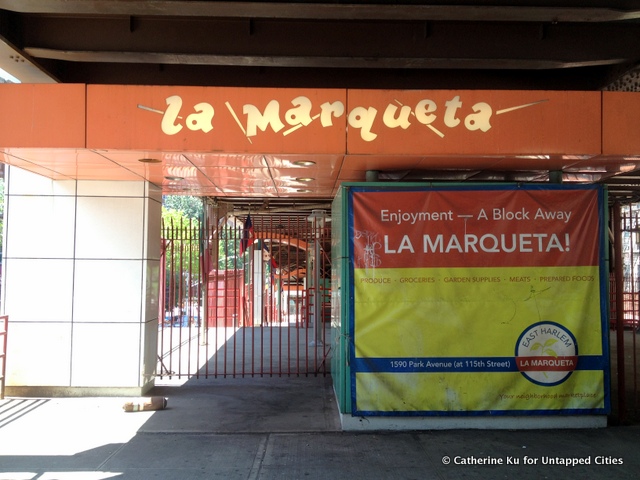 La Marqueta’s Flea Marqueta will open for the first time on Sunday under East Harlem’s Metro North tracks on E. 116 St. and Park Ave.
La Marqueta’s Flea Marqueta will open for the first time on Sunday under East Harlem’s Metro North tracks on E. 116 St. and Park Ave.
While it seems that dozens of open-air markets like the Brooklyn Flea, Smorgasburg and the Essex Street and New Amsterdam Markets have popped up in NYC, the seas of food vendors, artisans, locals and visitors have yet to venture far uptown. This absence will be filled this Sunday, when Flea Marqueta debuts at Harlem’s historic La Marqueta under the Metro North tracks at East 116th Street. Sunday’s collection of local vendors, business owners and performers will showcase Harlem‘s diverse culture and represents another development in the gradual revival of La Marqueta. The market was at its peak in the 1950s and 1960s, when it hosted over 500 vendors and was a major economic and social nexus of the neighborhood — the “spiritual heart of East Harlem,” according to the New York Times.
Flea Marqueta, which draws inspiration from the Brooklyn Flea and the Hell’s Kitchen Flea Market, is set to run from 12 p.m. to 6 p.m. every Sunday from June 23 to late October. Aside from food and art stalls, the market will have live entertainment each week, including a DJ and local performance groups. On June 30, GrowNYC will host a “Stop ‘N’ Swap,” during which people can trade used items for other’s that catches their eyes.
The venue’s layout will also contribute to its unique market experience. Unlike the open lots of other outdoor markets, Flea Marqueta’s multi-level floor plan requires vendors to get creative when setting up their booths. The overhead tracks, which quake every so often with the sound of passing trains, provides shelter for rainy days.
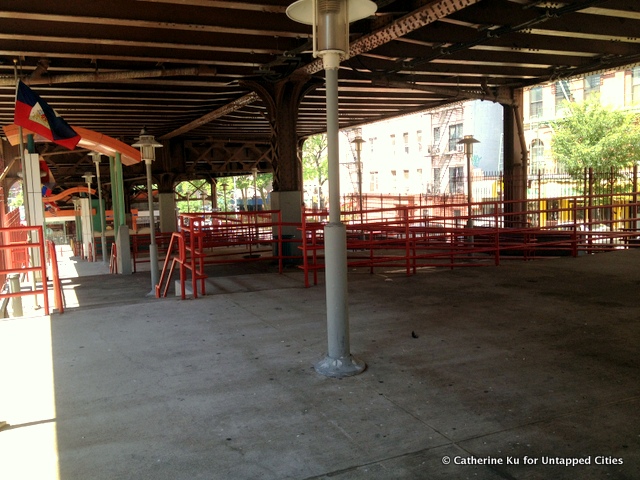
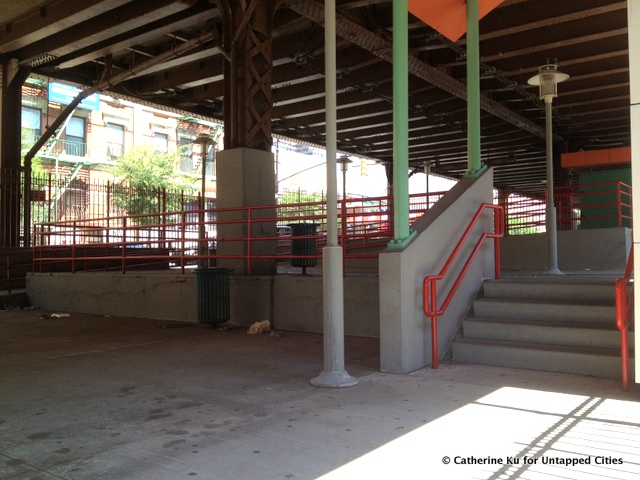 Flea Marqueta’s unique layout must accomodate a few different levels and lampposts.
Flea Marqueta’s unique layout must accomodate a few different levels and lampposts.
The name “La Marqueta” acknowledges East Harlem’s Latino heritage, but just a century ago, the area was predominantly Jewish and Italian. In the 19th century, East 111th to 116th Streets bustled with Jewish and Italian vendors, who gathered around the tracks to sell their wares from pushcarts. In 1936, then-mayor Fiorello LaGuardia ordered the construction of Park Avenue Market under the tracks, creating a centralized “modern, sanitary market.” From 1930 to 1960, East Harlem transformed into Spanish Harlem, and the market flourished as its overwhelmingly Hispanic population gave it its current name. The area’s urban decline in the 1970s hit East Harlem hard, and many businesses left the area. In the past decade, only a couple of La Marqueta’s five buildings have remained occupied. The others, along with surrounding storefronts, slowly deteriorated.
In the last few years, however, several attempts have been made to revitalize the area. The NYC Economic Development Corporation (EDC) renovated some of the market’s buildings. One now houses a smaller La Marqueta, home to a dozen shops such as Dorie Greenspan’s Buerre & Sal and the culinary/business incubator Hot Bread Kitchen, which helps low-income immigrant women become economically independent by training them to bake and sell bread.
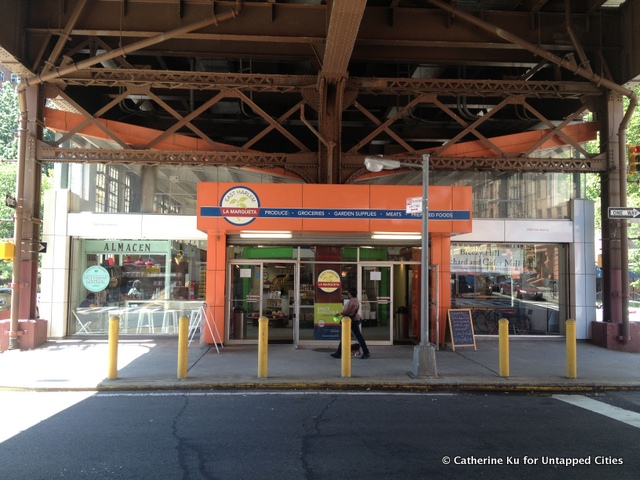
What remains of La Marqueta’s 500 vendors. This building, renovated by the NYCEDC, is home to a dozen vendors today.
The driving force behind Flea Marqueta — and one of the forces behind La Marqueta’s overall resurgence — is the husband-wife team of Dimitri and Sara Gatanas, owners of the Urban Garden Center across the street from the flea market space. Dimitri told us of his own decades-long Harlem roots with pride. His Greek grandparents lived in East Harlem and did their weekly shopping at La Marqueta. He grew up in Harlem and went to school in Washington Heights, and lived all over Manhattan before settling in New Jersey, from where he now makes his daily commute. Through the decades his family has seen Harlem transform ethnically, culturally and economically.
It’s jarring at first to see the splash of green under the rusty metal and gray concrete of the tracks. The Garden Center’s unexpected location is only one of its quirks. Inside, it’s easy to forget that there’s a city beyond the garden’s gates. Along with plants, the Garden Center is filled with recycled planters and furniture, many pieces which have been decorated by local artists. In the back, there is a henhouse with a few live chickens. The center hosts numerous community events such as field trips, weddings, communal composting and last year, held the first annual East Harlem Harvest Festival.
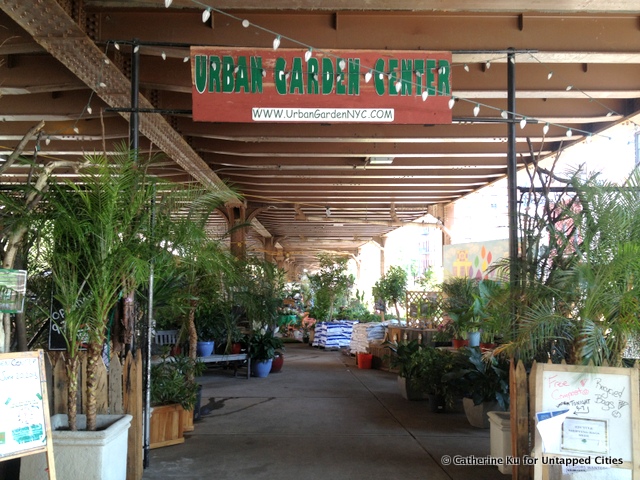
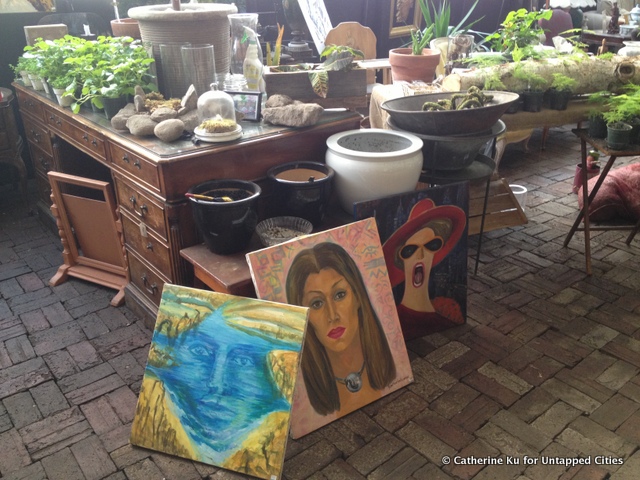
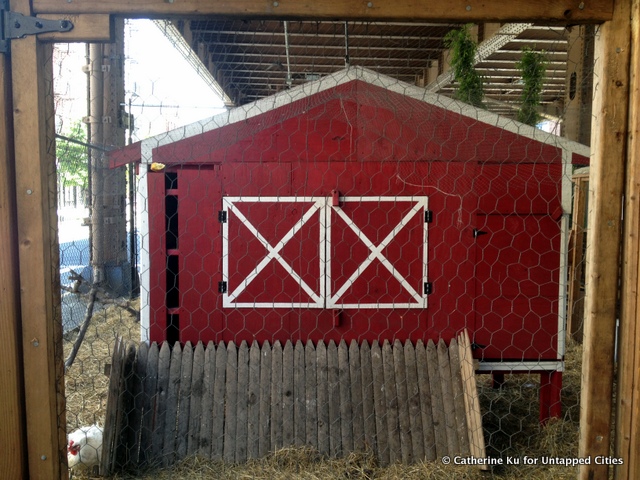 With its eclectic atmosphere and community programming, the Urban Garden Center has already begun to rejuvenate La Marqueta.
With its eclectic atmosphere and community programming, the Urban Garden Center has already begun to rejuvenate La Marqueta.
According to Dimitri, most people have no idea what today’s Harlem is like. “People live here,” he said. He introduced a man driving past us as a chef about to open a Moroccan food stand at the market, and referenced the popular owner of a La Marqueta stand that sells salted cod. When the Garden Center first opened in Harlem in 2010, there were four commercial vacancies on the surrounding corners. In the past three years, five new businesses have opened in the area.
“Now things are happening, and I’m saying, this could even be better if it was energized,” Dimitri said. La Marqueta’s location, he noted, occupies a unique crossroads between East and West Harlem, both areas of resurgence not only in economic development, but diverse culture as well.
When the Economic Development Corporation gathered proposals from community members on how to develop the space under the bridge, Dimitri said his first inclination was to suggest a retail and food space similar to Chelsea Market. The city liked the plan, and chose it over a proposed Walmart, a car wash and a shopping center.
“Why can’t Harlem have a really awesome market space?” Dimitri asked, listing the Brooklyn Flea, New Amsterdam, and Hell’s Kitchen as examples. “[La Marqueta is] made for this sort of thing.”
The current attempts to revitalize Harlem aren’t the first to be undertaken. Smaller scale attempts have included plans for street fairs and block parties, but Dimitri identified one barrier these events faced: “People don’t really know who’s behind it all.” In other words, the community wants a community-sponsored event, organized by people Harlem knows, and who know Harlem. Dimitri anticipated 30 vendors will appear on Sunday, with the potential to reach 50 vendors by the end of the summer. About 75% of those vendors, he said, will be local. The goal is to hold the market inexpensively and naturally.
Dimitri first announced plans for the market via Facebook, and has relied on word of mouth from neighbors, customers and a healthy network of Harlem bloggers to advertise. This past Wednesday, he and Sara held a vendor open call in which potential sellers displayed their products and competed for a free spot at the market. In general, there are no mechanized standards for vendors. Dimitri goes by what he calls a “feeling test,” and meets the vendors face to face.
“I want to know where they’re from, I want to know what they’re doing, I want to know why they did it. If it meets those simple standards, then let them come on board,” he told me. “I’m not looking for nail clippers, pillows and blankets … if you have blankets, it’s got to be interesting blankets.” The market may be called Flea Marqueta, but Dimitri wants the emphasis to be on quality, artisan products. He’s looking for enthusiastic local vendors with unique stories and goods who cannot afford to go to other markets, where it can be hard to get a stall. Some of the people he’s met with so far include a vendor of vegan borscht, a maker of intricate wooden jewelry and a produce seller who will offer Asian pears in an area where they’re hard to find. Eventually, Dimitri would like to welcome food trucks to the market as well.
The Asian pears reflect the balance Dimitri wants to strike between local and exotic. Along with its rich Italian and Jewish history, Harlem was also home to large German population — famed Yankee player Lou Gehrig was born to German immigrants on 2nd Avenue — and had a Greek presence as well. Now, Dimitri says the area has a growing number of Chinese nationals and Korean business owners.
“You’ve got to celebrate that,” he said, and to revive Harlem’s old spirit. He wants participation from all facets of Harlem’s community, especially those that are less visible to outsiders.
Sunday’s opening Flea Marqueta will be a celebration of many things: culture, community and Harlem’s past, present and future. If the slow, steady resurgence goes as planned, it should be quite a party under the railroad tracks this summer.
Get in touch with the author @catku.





